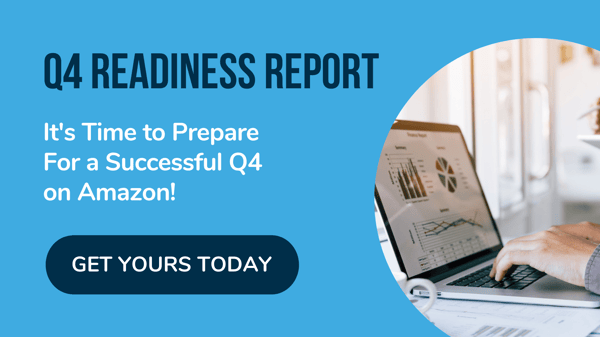 Now is the time to start preparing for Q4. And when it comes to winning on Amazon during the holiday season, simply keeping your catalog in stock is half the battle. Shoppers love the convenience and fast shipping that Prime facilitates. If your product isn’t available, they won’t struggle to find something else.
Now is the time to start preparing for Q4. And when it comes to winning on Amazon during the holiday season, simply keeping your catalog in stock is half the battle. Shoppers love the convenience and fast shipping that Prime facilitates. If your product isn’t available, they won’t struggle to find something else.
Making a watertight Q4 Amazon inventory management plan is an absolute necessity. Bobsled’s Nikhil Chothani has talked you through this process below.
What inventory data should brands be looking at
in anticipation of Q4?
When preparing for Q4, there are several factors to consider. From an inventory management perspective these data points are:
- Last Year Q4 (LYQ4) sales
- Year To Date (YTD) sales
- Prime Day 2021 results
- Q3 sales thus far (or the last 3 rolling months)
- 2020 top-selling SKUs during Q4
- And most importantly – current inventory and manufacturing capacity levels!
Using the ‘Business Report’ dashboard can be super helpful, especially when it comes to prioritizing SKUs during Q4. Here is a great tool to use when pulling data within the Business Report tab in Seller Central.
When looking at your sales history it’s important to understand not only which SKUs were the most popular, but drilling down further to identify how many units were sold. Looking at unit sales allows you to manage inventory accurately so you can avoid the Long Term Storage Fees (LTSFs) that Amazon implements if your inventory is overstocked or stays in their FCs for a long period of time.
The best time to prepare for Q4 is during the middle of Q3 as this is when brands can get a clear grasp of their inventory levels and which products are currently generating the most traction with Amazon shoppers. However, keep in mind the seasonal shift that occurs between Q3 and Q4 and how this will impact buyer intent across your catalog. For example, a Bobsled Home & Garden client did extremely well during summer selling their pool-focused SKUs. However, once winter comes, demand for this style of product will effectively evaporate.
And be sure to track inventory levels with your manufacturer as well! In order to send products to Amazon, you need to have the product FBA ready at your facility. Moreover, it’s prudent to always receive more inventory from your suppliers during Q4 for top sellers vs less. After you’ve forecasted the estimated Q4 unit sales, add a 10-15% buffer so you can keep some units for Fulfilled By Merchant (FBM) if you temporarily run out of FBA stock during the holiday season.
What are some tips for sending inventory to Amazon?
Be prepared for shipment delays to occur during Q4. It’s important to get your inventory in as early as possible. In 2021 Black Friday falls on Friday, November 26. This event is when Q4 Holiday shopping really starts picking up steam, so you’ll want to have everything humming along perfectly well before this point of the quarter to cash in on the huge uptick in traffic.
There are several ways you can send inventory to Amazon. Due to the sheer volume of shipments Amazon-owned trucks often get delayed in Q4. In this instance it may make sense to prioritize different carriers – you can find helpful information about this process here.
Also, how you send inventory to Amazon can make a huge difference. For high-priority ASINs, sending in smaller FBA shipments more frequently is the way to go. If a large shipment gets lost or delayed, this could really set you back a long time. Smaller shipments mean less risk and this generally equates to better account health.
💡Check out Winning Strategies for Amazon Inventory Management
What are some ways to overcome an overstock situation?
As illustrated by the below image, the Bobsled project makes a point of keeping inventory within the 0 to 180 days of supply in order to avoid any LTSF that occurs when hitting the 365+ days of supply.
Running Buy One Get One (BOGO) promos or leveraging Lightning Deals can be a great way to capture traffic and get rid of inventory that might be overstocked. In addition, using PPC advertising to target overstocked products and competitors’ offerings can help generate further traction on inventory you want to move.
💡Check out Which Amazon Promotions Work Best?
If selling excess inventory is still tough, the final option is to create a removal order so the units come back to you. This frees you up to promote the inventory via other offline or ecommerce channels e.g. Walmart, DTC.
What are some other Amazon inventory management
best practices?

Here are some more things you should be considering during the Q4 rush:
- In addition to reviewing unit sales from prior periods, consider other relevant factors such as PPC spend levels and promo strategies. If your traffic acquisition efforts will be considerably different in Q4 2021 don’t forget to adjust your inventory estimates accordingly.
- Plan to keep Prime-eligible offers running across your catalog throughout the entirety of Q4. In the event of a temporary FBA stock out, immediately switch over to Seller-Fulfilled Prime (SFP) or Fulfilled By Merchant (FBM) to avoid getting pinged by the Amazon algorithm.
- You can direct Amazon DSP traffic to Amazon or your DTC website. If inventory levels are getting low on one channel, consider changing the traffic destination so you can stay in stock.
💡Check out Using Amazon DSP During Q4
Can you provide an example of how Bobsled manages Amazon inventory from a strategic perspective?
During Prime Day 2020, a Bobsled client decided to run a Prime Exclusive Discount (PED) on a bestselling SKU. Unfortunately, this PED didn’t run due to an Amazon glitch. Therefore, we chose to run a 25% off coupon in place of the 20% off PED.
Because the coupon did not have the same visibility as a PED, early Day 1 sales weren’t as strong as originally anticipated. We regrouped internally and decided that getting to the end of Prime Day with excess inventory was the greater evil, so we pushed the ad spend lever not only to move inventory but also to drive top-line sales.
This pivot proved to be successful. We ended Day 1 with close to $20k in sales for this SKU and the full Prime Day event with $50k+ in sales for this SKU, and the total 2020 Prime Day sales eclipsed the 2019 event.
The takeaway here is that last-minute adjustments to pricing, ad spend and promos are sometimes necessary to maintain good inventory levels during high traffic periods such as Q4.

Tagged: Amazon Account Management, Operations
.png)


